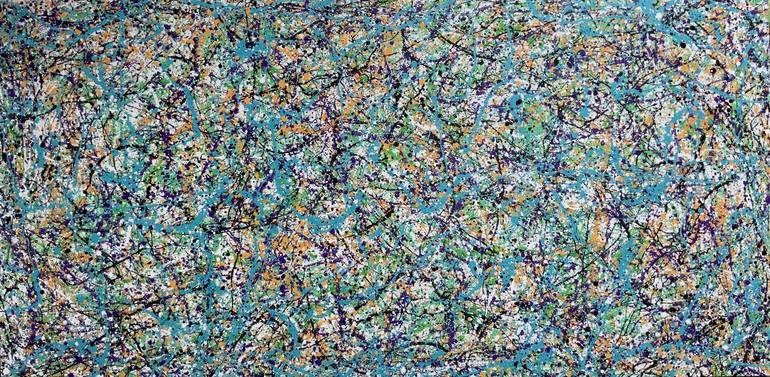



VIEW IN MY ROOM
Behind Blue Lines Painting
Painting, Acrylic on Canvas
Size: 72 W x 36 H x 1.5 D in
Ships in a Crate
Shipping included
14-day satisfaction guarantee
Artist Recognition

Artist featured in a collection
About The Artwork
No one knows what it's like To be the bad man To be the sad man Behind blue eyes And no one knows what it's like To be hated To be fated to telling only lies But my dreams they aren't as empty As my conscience seems to be I have hours, only lonely My love is vengeance That's never free No one knows what its like To feel these feelings Like I do And I blame you No one bites back as hard On their anger None of my pain and woe Can show through But my dreams they aren't as empty As my conscience seems to be I have hours, only lonely My love is vengeance That's never free No one knows what its like To be mistreated, to be defeated Behind blue eyes An no one know how to say That they're sorry and don't worry I'm not telling lies But my dreams they aren't as empty As my conscience seems to be I have hours, only lonely My love is vengeance That's never free No one knows what its like To be the bad man To be the sad man Behind blue eyes 'Behind Blue Eyes' by The Who Songwriter: Pete Townshend "Behind Blue Eyes" is a song by the English rock band The Who, recorded in 1971. It was the second single from their fifth album Who's Next and was originally written by Pete Townshend for his Lifehouse project. The song is one of The Who's best-known recordings and has been covered by many artists. "Behind Blue Eyes" originated after a Who concert in Denver on 9 June 1970. Following the performance, Townshend became tempted by a female groupie, but he instead went back to his room alone, possibly as a result of the teachings of his spiritual leader, Meher Baba. Upon reaching his room, he began writing a prayer, the first words being "When my fist clenches, crack it open..." These words later appeared as lyrics in the "climactic rocking section" of "Behind Blue Eyes." Source: Wikipedia
Details & Dimensions
Painting:Acrylic on Canvas
Original:One-of-a-kind Artwork
Size:72 W x 36 H x 1.5 D in
Frame:Not Framed
Ready to Hang:Not applicable
Packaging:Ships in a Crate
Shipping & Returns
Delivery Time:Typically 5-7 business days for domestic shipments, 10-14 business days for international shipments.
Handling:Ships in a wooden crate for additional protection of heavy or oversized artworks. Crated works are subject to an $80 care and handling fee. Artists are responsible for packaging and adhering to Saatchi Art’s packaging guidelines.
Ships From:United States.
Have additional questions?
Please visit our help section or contact us.
I’m (I am?) a self-taught artist, originally from the north suburbs of Chicago (also known as John Hughes' America). Born in 1984, I started painting in 2017 and began to take it somewhat seriously in 2019. I currently reside in rural Montana and live a secluded life with my three dogs - Pebbles (a.k.a. Jaws, Brandy, Fang), Bam Bam (a.k.a. Scrat, Dinki-Di, Trash Panda, Dug), and Mystique (a.k.a. Lady), and five cats - Burglekutt (a.k.a. Ghostmouse Makah), Vohnkar! (a.k.a. Storm Shadow, Grogu), Falkor (a.k.a. Moro, The Mummy's Kryptonite, Wendigo, BFC), Nibbler (a.k.a. Cobblepot), and Meegosh (a.k.a. Lenny). Part of the preface to the 'Complete Works of Emily Dickinson helps sum me up as a person and an artist: "The verses of Emily Dickinson belong emphatically to what Emerson long since called ‘the Poetry of the Portfolio,’ something produced absolutely without the thought of publication, and solely by way of expression of the writer's own mind. Such verse must inevitably forfeit whatever advantage lies in the discipline of public criticism and the enforced conformity to accepted ways. On the other hand, it may often gain something through the habit of freedom and unconventional utterance of daring thoughts. In the case of the present author, there was no choice in the matter; she must write thus, or not at all. A recluse by temperament and habit, literally spending years without settling her foot beyond the doorstep, and many more years during which her walks were strictly limited to her father's grounds, she habitually concealed her mind, like her person, from all but a few friends; and it was with great difficulty that she was persuaded to print during her lifetime, three or four poems. Yet she wrote verses in great abundance; and though brought curiosity indifferent to all conventional rules, had yet a rigorous literary standard of her own, and often altered a word many times to suit an ear which had its own tenacious fastidiousness." -Thomas Wentworth Higginson "Not bad... you say this is your first lesson?" "Yes, but my father was an *art collector*, so…"
Artist Recognition

Artist featured by Saatchi Art in a collection
Thousands Of Five-Star Reviews
We deliver world-class customer service to all of our art buyers.
Global Selection
Explore an unparalleled artwork selection by artists from around the world.
Satisfaction Guaranteed
Our 14-day satisfaction guarantee allows you to buy with confidence.
Support An Artist With Every Purchase
We pay our artists more on every sale than other galleries.
Need More Help?